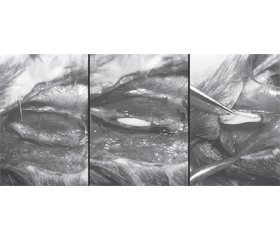Международный неврологический журнал Том 21, №2, 2025
Вернуться к номеру
Відновлення функції сідничного нерва після його тракційної травми в експерименті
Авторы: Вороді М.В. (1, 2), Петрів Т.І. (1), Нехлопочин О.С. (1), Цимбалюк В.І. (3)
(1) - ДУ «Інститут нейрохірургії ім. акад. А.П. Ромоданова НАМН України», м. Київ, Україна
(2) - Національний медичний університет імені акад. О.О. Богомольця, м. Київ, Україна
(3) - Національна академія медичних наук України, м. Київ, Україна
Рубрики: Неврология
Разделы: Клинические исследования
Версия для печати
Актуальність. Травми периферичних нервів є надзвичайно актуальною проблемою сьогодення, особливо в умовах воєнного часу. Украй високий відсоток інвалідизації поранених, через що вони не мають змоги повернутися до звичного життя, до 80 % постраждалих є непридатними до подальшої служби. Тому відновлення периферичних нервів є не тільки медичною, але й соціальною проблемою. Мета: дослідження функціонального відновлення сідничного нерва після його тракційної травми, визначення оптимальних стратегій його лікування. Матеріали та методи. Дослідження проводили на 30 безпородних щурах-самцях із середньою вагою 235 ± 55 г, які утримувались у стандартних умовах віварію ДУ «Інститут нейрохірургії ім. акад. А.П. Ромоданова» НАМН України з дотриманням усіх чинних норм біоетики. Щурів утримували за стандартним 12-годинним циклом світло/темрява з наданням вільного доступу до їжі та води. Тварини виводились з експерименту шляхом ін’єкції летальної дози тіопенталу натрію інтраперитонеально. В експерименті моделювали тракційну травму сідничного нерва. Далі тварин розподіляли на три групи залежно від обраного методу подальшого лікування та спостереження. Оцінювання відновлення функції сідничного нерва проводилося із застосуванням комплексного підходу, що включав Walking Track Analysis (тест ходьби по доріжці) з визначенням функціонального індексу сідничного нерва (SFI). Оцінювання проводили на 30-й і 60-й день після операції в І і ІІ групах, а також на 30-й і 60-й день після нанесення тракційної травми в ІІІ групі. Результати. Найгірше відновлення функції сідничного нерва спостерігалося в ІІ групі, тоді як найкращі результати регенерації були зафіксовані в ІІІ групі, у якій хірургічне втручання не виконувалося. При цьому показники груп I і III статистично значущо відрізнялись (p = 0,0027). Високі показники в ІІІ групі можна пояснити природною динамікою відновлення нерва після тракційного ушкодження, що підтверджено електронно-мікроскопічним дослідженням ушкоджених ділянок на 15, 30 і 60-й день після травми. Також слід відзначити низькі показники коефіцієнта варіації, отримані під час аналізу всіх наборів даних, що вказує на високу точність і надійність отриманих результатів. Висновки. Дослідження підтвердило ефективність природної регенерації сідничного нерва після тракційної травми, показавши найкращі результати в групі без хірургічного втручання. Хірургічні методи, такі як накладання епіневральних швів і тубаж із силіконовими імплантами, забезпечували часткове відновлення, проте їх ефективність була обмеженою.
Background. Peripheral nerve injuries are an extremely urgent problem today, especially in wartime. Very high percentage of disabled wounded people does not allow them to return to usual lives; up to 80 % of those injured are unfit for further service. Therefore, the restoration of peripheral nerves is not only a medical but also a social problem. The purpose was to study the functional restoration of the sciatic nerve after its traction injury and to determine the optimal treatment strategies. Materials and methods. The study was conducted on 30 outbred male rats with an average weight of 235 ± 55 g, which were kept in standard conditions of the vivarium of the State Institution “Romodanov Neurosurgery Institute of the National Academy of Medical Sciences of Ukraine” in compliance with all current bioethical standards. Rats were kept under a standard 12-hour light/dark cycle and provided with free access to food and water. The experiment was completed by sacrificing the animals with an intraperitoneal injection of a lethal dose of thiopental sodium. A traction injury to the sciatic nerve was simulated. Then the animals were divided into three groups depending on the chosen method of further treatment and observation. Assessment of restoration of the sciatic nerve function was performed using a comprehensive approach, which included Walking Track Analysis with determination of the sciatic functional index. Assessment was performed on the 30th and 60th day after surgery in groups I and II, as well as on the 30th and 60th day after traction injury in group III. Results. The worst recovery of the sciatic nerve function was observed in group II, while the best regeneration results were recorded in group III, where surgical intervention was not performed. At the same time, the indicators of groups I and III were statistically significantly different (p = 0.0027). High indicators in group III can be explained by the natural dynamics of nerve recovery after traction injury, which is confirmed by electron microscopic studies of damaged areas on the 15th, 30th and 60th day after injury. It should also be noted that the low coefficients of variation were obtained during the analysis of all data sets, which indicates high accuracy and reliability of the results. Conclusions. The study confirmed the effectiveness of natural regeneration of the sciatic nerve after traction injury, showing the best results in the non-surgical group. Surgical methods, such as epineural sutures and silicone tube insertion, provided partial recovery, but their effectiveness was limited.
тракційна травма периферичного нерва; модель; функціональний індекс сідничного нерва; експеримент
peripheral nerve traction injury; model; sciatic functional index; experiment

